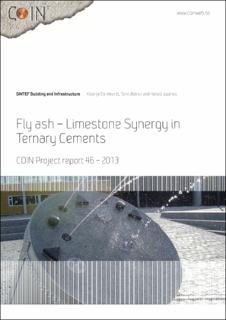| dc.description.abstract | The objective is to study the parameters of cements and fly ashes in combination with limestone that would optimize the synergistic chemical reaction between fly ash and limestone that leads to more bound water and thereby less porosity and higher compressive strength.
Most notably this will be the reactive aluminate content of cements and fly ashes and how these will be able to combine with limestone to calcium carboaluminate hydrate at a given point in time.
Four cement clinkers with two gypsum levels were combined with four different fly ashes and one limestone powder (the type used for raw meal in cement production).
The study was carried out in two steps: 1) Combination of clinkers with two levels of gypsum (1.5% and 3.0% replacing clinker) and 0 and 5% limestone powder replacing clinker + gypsum. 2) Clinkers, each with 3 % gypsum, replaced with 35% fly ash and where 0 or 5% fly ash was replaced with limestone.
The cement clinkers are usually believed to contain so little aluminate in the form of the mineral C3A that the limestone has so little to react with in order to form calcium carboaluminate hydrate and stabilize ettringite (i.e. the synergic reaction) that the influence of limestone on the 28 days strength would be negligible. The 28 d strength was mostly unchanged when 5% limestone replaced cement (i.e. clinker + gypsum) which means that limestone actually has the same efficiency factor as cement with respect to 28 d strength, so it is likely that some reaction has happened.
However, there was a huge difference in 28 days strength between the clinkers, ranging from 44.6 MPa to 67.1 MPa when combined with for instance 3% gypsum. The reason for this is discussed, but it was not obvious from the clinker characteristics. Nevertheless, the clinker achieving the highest strength had the highest alite (C3S) content and either an aluminiumrich alite or an x-ray amorphous aluminium containing phase. This clinker was also the only clinker showing a significant strength increase when replaced with 5% limestone, indicating an aluminate interaction in spite of having lower C3A content than other clinkers. Limestone replacing cement gave also the same 1 day strength as pure cement, indicating the same efficiency factor as cement.
Among the fly ashes in step 2, there were 3 ordinary fly ashes and 1 rich in anhydrite (12% calcium sulphate). The latter fly ash gave always the highest 28 days strength when 35% was replacing the four different clinkers with 3% gypsum. It raises the question whether or not one just as well could add more gypsum rather than limestone in combination with the fly ashes. Replacing 5% of the other 3 fly ashes with limestone gave always a strength increase, meaning the efficiency factor of limestone is higher than the fly ash, presumably due to the synergic reaction. The strength gain by limestone replacing fly ash combined with the different clinkers gave a good linear correlation with the amount of glass in the fly ash multiplied by the alumina content in that glass. This "multiplication factor" probably corresponds to the amount of alumina "easily" available by the fly ash to the system in the pozzolanic reaction and that the degree of reaction for the 3 fly ashes in the regression was about equal at 28 days.
Finally, mortars where 35% calcined marl replacing the clinkers with 3% gypsum were made in order to compare with the fly ash performance. Calcined marl gave higher strength than any of the fly ashes and even led to higher strength than mortars based on 100% clinker + gypsum for 3 out of 4 clinkers (even for the one with highest strength; 67.1 vs. 75.5 MPa). | |
